

Vol. 38 (Nº 12) Año 2017. Pág. 10
Daniel JORGE 1; Dario ALLIPRANDINI 2; Gabriela SCUR 3
Recibido: 15/09/16 • Aprobado: 30/09/2016
2. Portfolio management models
ABSTRACT: Managing projects is a challenge for companies because many and different projects may be developed in alignment with strategies and financial priorities. Although there is a consolidation in the literature related to project management in new product development projects, there are few applications in industrial projects such as layout changing, capacity increase projects or retrofit projects. Due to the lack of resources to conduct many projects simultaneously, companies should use project management tools in order to select and prioritize them. This paper presents the development and application of a framework to prioritize industrial projects, based on portfolio management and prioritizing models. The framework was applied in a Brazilian subsidiary of a global automotive company. It was analyzed 681 industrial projects from 2014 to 2016. The results addressed that the use of prioritizing method improves the decision making on selecting and ranking projects concerning strategic issues, financial constraints and legal requirements. Besides, it was observed that the application of the framework allowed a reduction in terms of the selected projects kick-off. |
RESUMEN: Gestión de proyectos es un reto para las empresas porque muchos proyectos pueden desarrollarse con la alineación de estrategias y prioridades financieras. Aunque existe una consolidación en la literatura relacionada con la gestión en proyectos de desarrollo de nuevos productos, hay pocas aplicaciones en proyectos industriales como el cambio de diseño, capacidad de aumentar proyectos o adaptarlos. Debido a la falta de recursos para llevar a cabo muchos proyectos al mismo tiempo, las empresas deben utilizar herramientas de gestión de proyectos con el fin de seleccionar y priorizarlos. Este trabajo presenta el desarrollo y aplicación de un marco para dar prioridad a proyectos industriales, basado en la gestión de cartera y dar prioridad a los modelos. El marco se aplicó en la filial brasileña de una empresa automotriz global. Fue ron analizados 681 proyectos industriales de 2014 a 2016. Los resultados determino que con el uso de prioridades el método mejora la toma de decisiones en la selección y clasificación proyectos relativos a cuestiones estratégicas, las limitaciones financieras y requerimientos legales. Además, se observó que la aplicación del marco permite una reducción en términos de lo proyectos seleccionados en su inicio. |
Project has been the main method used to implement changes and growth investment strategies, through new products, specific clients attendance, new technology or legal requirements adequacy, impacting of an increase of variability on application areas, generating an increment on the number of projects on the organization (Graham and Englund, 2013; Voss, 2012; PMI, 2008).
The management of a high number of projects demands specific techniques to support the stakeholders to focus the better resource application. Besides that, the complexity of the project portfolio management makes few organizations to have access to their practices, the benefits with few successful implementations. (Rabechini Jr et al, 2005).
There are many papers related to product portfolio management. However, there is a gap in the literature regarding the implementation of project portfolio management outside the scope of new products (Padovani et al, 2010). Therefore, this paper focus on industrial projects, thus allowing the implementation priorities, giving an academic contribution to portfolio management area and a practice model for application in a business environment.
The main objective of this paper is to propose a prioritization model for industrial projects based on portfolio management models and prioritization methods requirements, resulting in a research question: how can companies prioritize their industrial projects, meeting the strategic, corporate and business requirements, by the use of portfolio management and prioritization method concept application?
To answer this question, this used paper works in two stages. In the first stage was done a literature review of the main portfolio management models and prioritization methods, with focus on a proposal of a portfolio management model for industrial projects. In the second, it was conducted a case study in a car assembly plant to test the proposed model.
The benchmark models in the literature about portfolio management area are of Wheelwright and Clark (1992), Cooper et al (1997a), Archer and Ghasemzadeh (1999) and PMI (2013).
According to Wheelwright and Clark (1992), the structure of a portfolio reflects the categorization considering the level of change in product and process demand. This categorization gives to the stakeholders an overview of resource demanded to each project and its implementation contribution to the current company’s products portfolio.
The portfolio model review developed by Cooper et al (1997b), works with the strategy for new products and business, exchanging information between them.
PMI (2013) proposes a model based in two group of process: alignment and monitoring. The alignment process is based on the organization’s vision and mission.
Archer and Ghasemzadeh (1999) proposes the framework for project portfolio selection (see Figure 1), adopting the project portfolio selection as a stream of actions influenced by the organization's strategy and the methodology selection.
Figure 1. Framework portfolio selection
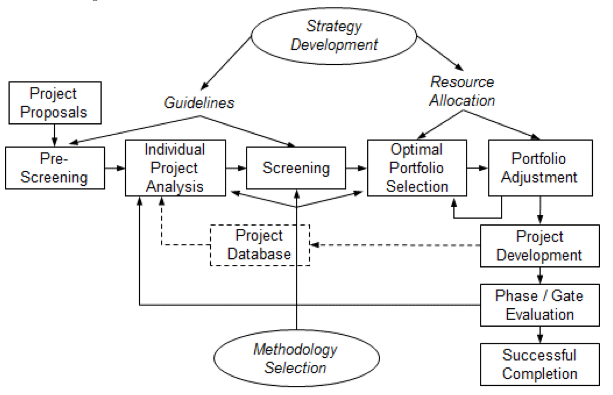
Source: Archer and Ghasemzadeh (1999).
The portfolio management models converge in five key processes – individual project analysis; classification or categorization of projects; project evaluation; projects selection and prioritization; monitoring and control. These five processes are the key for the development of the project portfolio model, i.e. they are the model requirements.
In Table 1 are presented the key processes for project portfolio management models and how each of the models analysis approaches.
Table 1. Key processes of project portfolio management models.
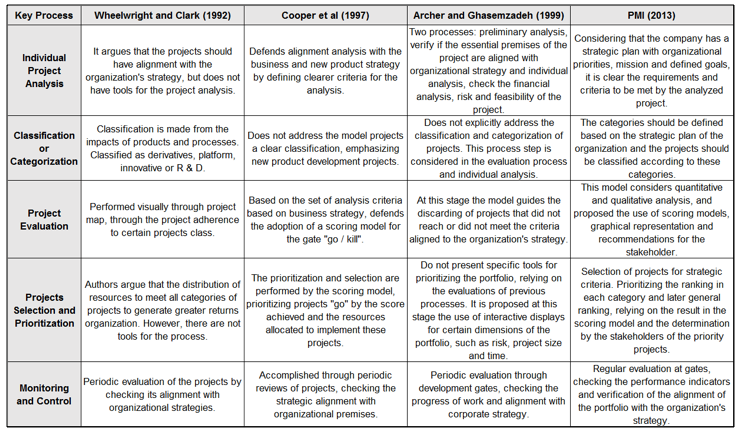
Source: authors
The portfolio selection demands simultaneous projects comparison in specific dimensions to obtain an optimized project sequence. Highly rated projects in the evaluation criteria are selected for the portfolio, becoming able to receive resources to implementation (Archer and Ghasemzadeh, 1999).
As mentioned by Carvalho et al (2013), prioritization methods are classified as financial methods, mathematical programming, statistics modeling, bubbles diagram, fuzzy logical, decision tree, scoring models and multiple criteria decision (AMD) and many authors (Dutra, 2012; Carvalho et al, 2013; Castro and Carvalho, 2010a; 2010b; Danilevicz and Ribeiro, 2013; Jaeger Neto et al. 2013; Padovani et al, 2012; Figueiredo and Silva, 2014; Quinlan, 1986; Morber and Elmaghraby, 1978; Cavalcante and Almeida, 2005; Lima et a.l 2014; Pedroso et al 2012) discuss the vantages and disadvantages of each tool. In order to summary the main contribution of these authors the table 2 was developed. Table 2 presents the methods with the basic description and their strengths and weaknesses.
Table 2. Prioritization methods
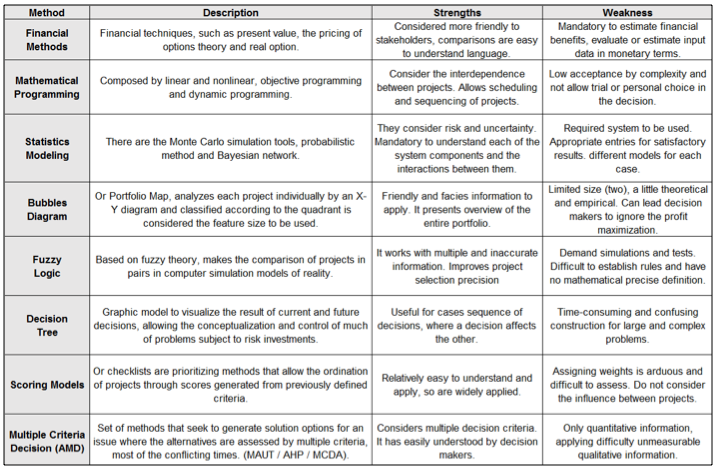
Source: authors
Based on portfolio management models analysis – key process (Table 1) and prioritization methods (Table 2), we note that there are important features to the context of industrial projects in the framework proposed by Archer and Ghasemzadeh (1999) and the prioritization method of scoring model.
The framework has features like the division of individual process analysis in pre-screaming and individual analysis, a periodic evaluation through gates, a feedback system and a database to maintain the projects waiting for implementation. In the prioritization, process the scoring model application means: easy application, understanding and implementation. Figure 2 presents the proposal Project portfolio management model to industrial projects.
Figure 2. Project portfolio management model
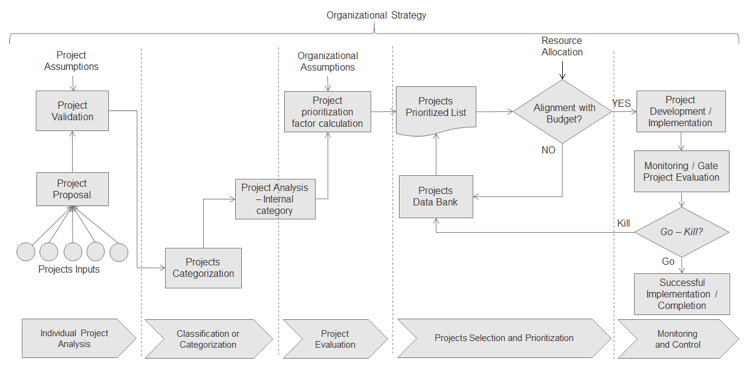
The model is based on the key process, such as: individual projects analysis, classification or categorization, project evaluation, projects selection and prioritization and monitoring and control.
Individual Projects analysis – start with the projects proposals inputs based on the organization’s needs. The information formatted and formalized generates a project proposal. The validation of the proposed project proposal is made by analyzing the basic requirements of a project - scope, quality, chronogram, budget, resources and risks - as well as the expected outcome of the project (PMI, 2008). This stage analyzes the technical feasibility of a project implementation, financial evaluation (where applicable) and the strategic alignment with the organization’s assumptions and premises (Archer and Ghasemzadeh, 1999; PMI, 2008; Unger et al, 2012; Castro and Carvalho, 2010a; Cooper et al, 1997a). For the projects proposal evaluation, a checklist method based on 5W2H (Falconi, 1999; Slack et al, 1999) is presented in Table 3.
Table 3. Projects proposal evaluation method
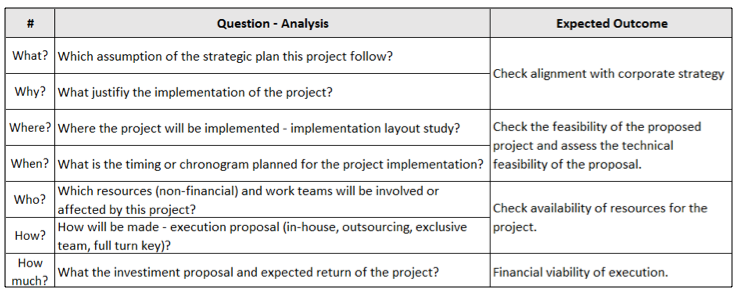
Source: authors
Classification or Categorization – with the valid projects proposal begins the projects classification process in categories. Based on the projects database from “Organization”, the projects categories are “Safety” – projects to avoid or prevent problems or serious safety incidents, aiming to work in a safety requirement or issue in the organization. “Regulatory” – projects to avoid violations or non-compliance with existing or new standards and regulations, aiming to work at risk for legal or regulatory non-compliance. “Assets Sustainable” – projects aiming to eliminate or reduce productivity loss due to downtime, assets technology update, reform, upgrade, retrofit and replacement to extend the useful life of the equipment. “Productivity” – projects with payback of investment within 2 years after implementation.
Project Evaluation – After the projects validation and categorization, it follows for the analysis of internal design category. In this analysis, we propose the establishment of a decision criteria, operationalized by applying a questionnaire for each industrial projects category, presented in Table 4, and defining prioritization criteria internal to the category, classifying and measuring the projects for prioritization (Cooper et a.l, 1997a; 2001; PMI, 2013; Pedroso et al., 2012; Padovani et al. 2012).
Table 4. Projects proposal evaluation method.
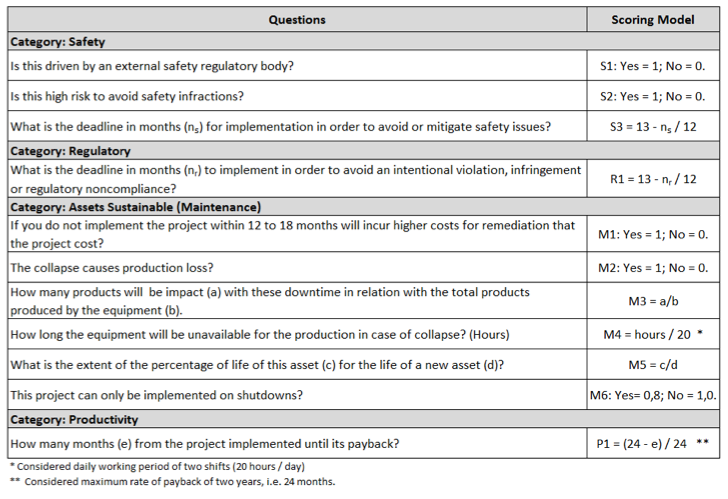
Source: authors
Each category, it has a formula to define the total score to the analyzed project – scoring model, as follows:

Projects Selection and Prioritization - with the evaluation of projects determining the internal categories scores, it follows for the project prioritization factor. As shown by Steenackers and Goovaerts (1989) that proposes the use of a linear function for project prioritization factor calculation. The linear function to calculate project prioritization factor (FG) is expressed by equation (5):

The category factors fS,fR, fM e fP are related to organizational requirements and fG is a strategic management factor to stakeholders use, increasing score for a specific and strategic project. The prioritized consolidated project list is made by ordering the FG from the highest to lowest. Through a cross check, the list of priority projects and the project budget define the water line, that is, projects that have financial resources available.
Monitoring and Control - with the prioritized projects with consolidated resources and formalized execution list, starts execution and implementation activities.
We refer to the studied company as Organization due to a confidentiality agreement. The Organization is a car assembly plant, installed in Brazil by an American multinational industry.
The Organization has an extensive projects portfolio but in this paper, we focus on the industrial projects portfolio from 2014 to 2016, considering 117 projects to 2014, 230 projects to 2015 and 334 projects to 2016.
We have 86 valid projects to 2014, 72 projects to 2015 and 123 projects to 2016 after individual project analysis phase.
Considering the Organizations requirements for industrial projects, category factors (fS,fR, fM e fP ) are defined. The value for category factors and the number of projects analyzed in each category per year are presented on Table 5.
Table 5. Total projects and factor by category from 2014 to 2016
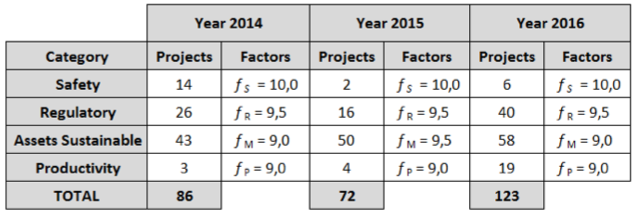
Source: authors
Calculating to all analyzed projects the scores to S, R, M and P, by the equations (1), (2), (3) and (4) respectively, and, applying the equation (5), we will obtain the previous global prioritization score (FG’) where through ordering FG’ from the highest to the lowest, it forms de previous prioritized projects list.
At this point, the stakeholders have a tool to increase the score of particular projects, due to strategic or personal requirements. Archer and Ghasemzadeh (1999) indicate this feature as fundamental to the portfolio management models applicability in the companies, giving to stakeholder’s autonomy to prioritize or postpone projects in the model.
Considering the approved projects budget from 2014 to 2016 and the prioritization list for the years, the water line positioned defines the projects that will receive resources. The projects that are under the water line are send to Projects Data Bank. The project database also receives projects that failed in the monitoring phase and control on the go-kill gate, which can be re-studied or simply discarded.
The results of the industrial project portfolio model analysis for the year 2014, compared with the actual portfolio of Organization is shown in Table 6, considering the 20th first projects and the category factors fS=10,0, fR=9,5, fM=9,0 e fP=9,0.
Table 6. Industrial projects prioritized list – 2014.
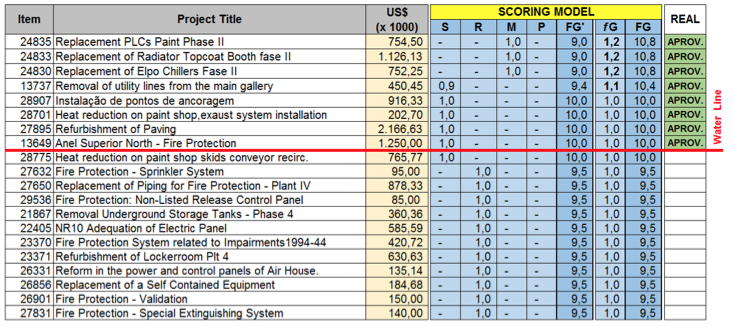
Source: authors
Similarly, for the year 2015, considering the 20th first projects and the category factors fS=10,0, fR=9,5, fM=9,5 and fP=9,0 is shown in Table 7.
Table 7. Industrial projects prioritized list – 2015.
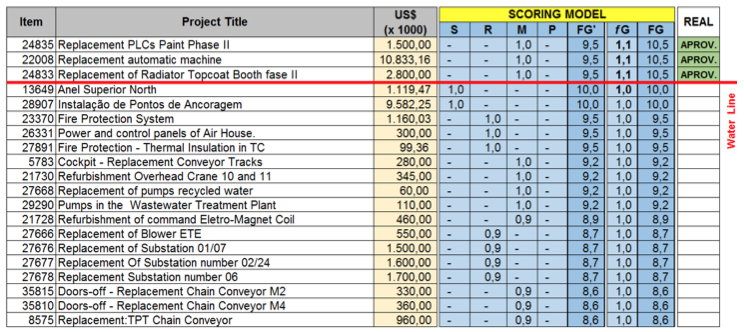
Source: authors
Similarly, for the year 2016, considering the 20th first projects and the category factors fS=10,0, fR=9,5, fM=9,0 e fP=9,0 is shown in Table 8.
Table 8. Industrial projects prioritized list – 2016.
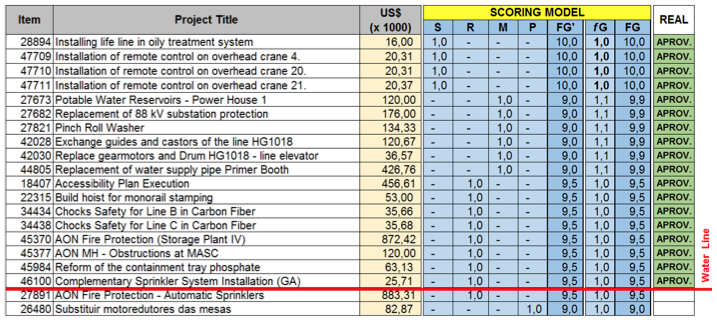
Source: authors
On the Tables 6, 7 and 8, the water line presented by the budget available in each year, separates the projects that will go to implementation phase. The projects under the water line stays at a project data bank waiting for resources available from “killed” programs or waiting for the next prioritization list.
The real prioritization project list compare with the list obtained by proposed model application shows a high degree of coherence and grip notice by the analysis the lists from 2014 to 2016 presented on Tables from six to eight.
The use of the strategic management factor (fG) to adjust the final list of projects was low, with 4 times used in 2015 (25%) and 3 times used in 2016(33%), except for the year 2015 where the approval of projects was fully strategic. The low use of fG represents a high reliability in the model for the analysis of industrial projects portfolio.
This paper presents the development of a proposal for portfolio management model and application prioritization method in industrial projects, verifying its usefulness, relevance and consistency with real situations of decision-making process.
In the model proposed stakeholders have at least two features to portfolio control, through strategic management factor (fG) and through the categories factors (fS, fR, fM and fP) as recommended by Archer and Ghasemzadeh (1999). Also strategic alignment devices projects through the project assumptions and organizational assumptions as described and recommended by Archer and Ghasemzadeh (1999), Cooper et al (1997a, 1997b) and PMI (2013).
The implementation of the proposed model, based on Archer and Ghasemzadeh (1999) framework and the key-process for a portfolio management model, presenting a logical system very next to practical environmental of companies with large industrial projects portfolios, and the association with a prioritization tool easy to understand and apply, make the proposed model a low complexity in application, attractive and allowing to get the benefits of implementation.
The use of prioritization method of scoring model associated with the current Organization’s database for projects became the weights and values allocation to projects easier, minimizing the negative characteristic indicated by Dutra (2012) and Carvalho et al (2013). However, the facility pointed by the authors in the application and understanding of the model logic proven in the practical application of the model.
According Rabechini et al (2005), few organizations use management tools to a large number of projects reflects the inherent complexity of the models, so the facilities presented by the model are of fundamental importance for the consolidation of the model in the application and disclosure of the same for the rest of the Organization.
On the other hand, the negative feature indicated by Dutra (2012) that a scoring model does not consider the influence between projects is not relevant in practical application, mainly by the point that Organization’s industrial projects resource scarcest is financial, making workforce or equipment execution been directed to outsourcing or internal implementation. However, synergy between projects was possible using the strategic management factor (fG) in 2014 and 2015, prioritizing the projects 24833 and 24835, which in addition to having common implementation strategies, shared the same execution resources.
In this work is possible to verify the adhesion between the proposed model and the actual results achieved in the Organization, providing a model for managers and decision makers an efficient and aligned process the reality of the studied company.
The major contribution of the proposed model is the increase of speed to process and obtain the prioritized projects list, reducing the baseline of two months to a process of some days, representing a drastic time reduction on stakeholders and analysts time analysis.
Therefore, we can see that the model proposed in this paper provides managers and decision makers an efficient process management and prioritizing the portfolio of industrial projects.
In the papers context of an application for internal use to an organization, the prioritization method score was adequate. However, in a general application of the model, would be make a study for the incorporation of other prioritization tools, such as the AHP as an example of AMD type tool, statistical modeling such as simulation Monte Carlo, or even tools for balancing the portfolio as the diagram bubbles.
Other suggestion of future works is the application of the proposal model as a tool for optimizing the use of financial resources released for development projects. The portfolio of prioritized projects does not influence the decision on the amount of released funds and this is a job opportunity with a focus on bringing the prioritization model to support this decision.
Archer, N.P., Ghasemzadeh, F. (1999). An integrated framework for project portfolio selection. International Journal of Project Management, 17, 207-216.
Carvalho, M.M., Lopes, P.V.B.V.L., Marzagão, D.S.L. (2013). Gestão de portfólio de projetos: contribuições e tendências da literatura. Gestão e Produção, 20, 433-454.
Castro, H.G.D., Carvalho, M.M.D. (2010a). Gerenciamento do portfólio de projetos (PPM): estudos de caso. Produção, 20, 303-321.
Castro, H.G.D., Carvalho, M.M.D. (2010b). Gerenciamento do portfólio de projetos: um estudo exploratório. Gestão e Produção, 17, 283-296.
Cavalcante, C.A.V., Almeida, A. T.D. (2005). Modelo multicritério de apoio a decisão para o planejamento de manutenção preventiva utilizando PROMETHEE II em situações de incerteza. Pesquisa Operacional On-Line, 25, 279-296.
Cooper, R.G., Edgett, S. J., Kleinschmidt, E.J. (1997a). Portfolio management in new product development: Lessons from the leaders-I. Research Technology Management, 40, 16-28.
Cooper, R.G., Edgett, S. J., Kleinschmidt, E.J. (1997b). Portfolio management in new product development: Lessons from the leaders-II. Research Technology Management, 40, 43-52.
Danilevicz, A.D.M.F.; Ribeiro, J.L.D. (2013). Um modelo quantitativo para a gestão da inovação em portfólio de produtos. Gestão e Produção, 20, 59-75.
Dutra, C.C. (2012). Modelo econômico-probabilístico para a seleção e priorização de projetos. UFRGS, Porto Alegre.
Falconi, V.C. (1999). TQC - Controle da Qualidade Total (no estilo japonês). DG, Belo Horizonte.
Figueiredo, C.J., Silva, M.H.L.D. (2014). Abordagem multicritério e lógica fuzzi para priorização de portfólio de produtos em um sistema agroindustrial. PODes - Revista Eletrônica Pesquisa Operacional para o Desenvolvimento, 6, Rio de Janeiro, 226-242.
Graham, R.J., Englund, R.L. (2013). Creating an environment for successful projects. John Wiley & Sons.
Jaeger Neto, J.I., Luciano, E.M., Testa, M.G. (2013). Identificando o potencial de inovação das organizações por meio da análise do portfólio de projetos de tecnologia da informação. Gestão e Produção, 20, 495-510.
Lima, M.T.D.A.D., Oliveira, E.C.B.D., Alencar, L.H. (2014). Modelo de apoio à decisão para priorização de projetos em uma empresa de saneamento. Produção, 24, 351-363.
Morber, J.J.; Elmaghraby, S.E. (1978). Handbook of operational research models and applications, New York.
Padovani, M., (2007). Apoio à decisão na seleção do portfólio de projetos: uma abordagem híbrida usando os métodos AHP e programação inteira. (Masters dissertation) USP – São Paulo.
Padovani, M.; Carvalho, M.M.D.; Muscat, A.R.N. (2010). Seleção e alocação de recursos em portfólio de projetos: estudo de caso no setor químico. Gestão e Produção, 17, 157-180.
Padovani, M.; Carvalho, M.M.D.; Muscat, A.R.N. (2012). Ajuste e balanceamento do portfólio de projetos: o caso de uma empresa do setor químico. Produção, 22, 651-673.
Pedroso, C.; Paula, I.C.D.; Souza, J.S.D. (2012). Análise comparativa de ferramentas de gestão de portfólio: um estudo de caso na indústria alimentícia. Produção, 22, 637-650.
Project Management Institute , PMI (2008). Guia PMBOK - Um Guia do Conhecimento em Gerencimento de Projetos. ed 4. . Project Management Institute, Inc. Newtown Square – PA
Project Management Institute , PMI (2013). The Standard of Portfolio Management. 3. ed. Project Management Institute, Inc. Newtown Square – PA.
Quinlan, J. R. (1986). Induction of Decision Trees. Machine Learning 1, 81-106.
Rabechini Jr, R.; Maximiano, A.C.A.; Martins, V.A. (2005). A adoção de gerenciamento de portfolio como uma alternativa gerencial: o caso de uma empresa prestadora de serviço de interconexão eletrônica. Produção, 15, 416-433.
Slack, N., Chambers, S., Harland, C., Harrison, A., Johnston, R. (1999). Administração da Produção. Atlas, São Paulo.
Steenackers, A.; Goovaerts, M. J. (1989). A credit scoring model for personal loans. Insurance: Mathematics and Economics, 8, 31-34.
Unger, B. N., Kock, A., Gemünden, H.G., Jonas, D. (2012). Enforcing strategic fit of project portfolios by project termination: An empirical study on senior management involvement. International Journal of Project Management, 30, 675-685.
Voss, M. (2012). Impact of customer integration on project portfolio management and its success— developing a conceptual framework. International Journal of Project Management, 30, 567-581.
Wheelwright, S.C.; Clark, K.B. (1992). Creating project plans to focus product development. Harvard Business School Pub.
1. Master in Mechanical Engineering at University of FEI
2. Adjunct Professor at Department of Production Engineering in the University of FEI, Brazil. Associate Professor in the Master's Program in Engineering Mechanics at FEI University. Master and PhD in Mechanical Engineering (1982 and 1996) and Pos-doc at the School of Industrial Engineering of Georgia Institute of Technology, Atlanta, USA (2000-2001).
3. Adjunct Professor at Department of Production Engineering in the University of FEI, Brazil. Associate Professor in the Master's Program in Engineering Mechanics at FEI University. Degree in Business (1997), a Master’s in Business (2000) and a PhD in Production Engineering at the University of São Paulo, Brazil (2005). Visiting fellow at the University of Padua, the Institute of Economics, Italy, in 2005. Has experience in innovation, sustainability and operations strategy. Email: gabriela@fei.edu.br